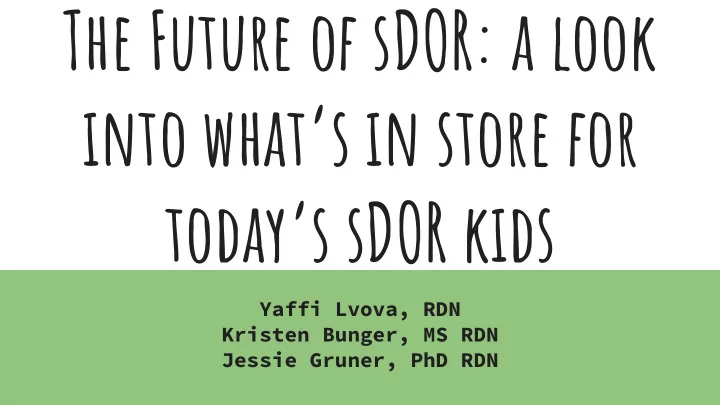

The Future of sDOR: a look into what’s in store for today’s sDOR kids Yaffi Lvova, RDN Kristen Bunger, MS RDN Jessie Gruner, PhD RDN
Agenda sDOR Yaffi Lvova, RDN Competent and Intuitive Relationship with Food Kristen Bunger, MS, RD Body Satisfaction and Health Jessie Gruner, PhD, RDN Questions
Story Time
sDOR Yaffi Lvova, RDN
Internal Cues Parent Child Feeds on demand Roots ❖ ❖ Chews on fist ❖ Natural reflex to ❖ cheek stroke Turns head away ❖ Milk drunk ❖ Present From Birth
What is sDOR? Parent Child What is being served Whether she will eat ❖ ❖ When it is being How much she will ❖ ❖ served eat Where it is being The pace at which ❖ ❖ served she will eat Nutrition is a marathon, not a sprint
What sDOR isn’t! 1. You’re not a short order cook a. All food in the house isn’t fair game at any time in the day - that’s not how kids learn how to self-regulate 2. Not a pressured table environment 3. Child won’t live on noodles forever
What’s Next? Graduating from sDOR, continue to reinforce those ● internal cues Increasing responsibility for kids ● Transitioning tasks to kids ●
Where is your client starting?
The Bridge from sDOR Deconstructed meals Cooking together Shopping together Recipe selection Meal planning (partial → full) Restaurant selection Snack shelf Packing own lunch When to start?
Competent and Intuitive Relationship with Food Kristen Bunger, MS, RD
Where Does the Bridge Lead? Spoiler Alert! 1. Comprehensive health. 2. Absence of guilt/shame/preoccupation with food. 3. Enjoyment of food. 4. Gentle nutrition. 5. Body positivity. 6. Enjoyment of movement. 7. Weight/size acceptance.
The Bridge from sDOR to Competence and IE? 1. Why is this bridge so important? a. Efficacy of treatment. b. Weight/size bias impedes progress. c. Reinforce the importance of internal cues. 2. How to know if you are on the “bridge.” a. Language with kids versus adults. b. Are you fighting with me in your head right now? c. Knowledge/fear without experience. d. Alternative metrics of health to measure success.
What is EAting competence? What is IE? Competent Eating (key elements) ● The discipline of providing yourself with regular, reliable, and ○ rewarding meals and snacks and paying attention while you eat. The unconditional permission to eat what and as much as you want at ○ those regular times. Intuitive Eating (key elements) ● Unconditional permission to eat. ○ Eating for physical rather than emotional reasons. ○ Reliance on internal hunger/satiety cues. ○
Comparing CE and IE! 1. Similarities of these two models. a. Models versus ideas. b. Based on permission. c. Widely accepted. 2. Differences between the two. a. Scheduled or not? Benefits of both models. 3. What they are not! a. Free for all! b. Self-control versus restriction. c. Excuses to ignore disease states present.
Body Satisfaction and Health Jessie Gruner, PhD, RDN
Body Satisfaction
Weight Stigma Impacts Health Increased risk of ● Eating disorders ○ Weight cycling ○ Depression ○ Less likely to join in physical activities ○ Higher overall weight gain ○ Poor school performance ○ Increased isolation ○ (Pont, 2017; Brewis & Bruening, 2018)
Why weight is a poor indicator of health BMI is a poor indicator of metabolic ● risk ~50% of overweight, 29% of obese ● and 16% of individuals with type 2 & 3 obesity were metabolically HEALTHY. >30% of normal weight individuals ● were metabolically UNHEALTHY Using BMI alone would misclassify ● an estimated 75 million people (Tomiyama AJ, 2016)
Body Image Culture 2019
http://decipher.uk.net/can-we-do-good-public-health-without-fat-shaming/
Weight SHaming
Story Time Reflection
The Role of Weight Bias
Implicit Weight Bias 9-11 yo more likely to rate ● healthy-weight children as “good” Similar to implicit racial ● bias among adults (Skinner et al., 2017)
What does this look like in practice? First, do no harm. Acknowledge the complex etiology of obesity. What other indicators can you use besides weight? How can you promote positive body images in your work?
Messaging in Practice
“We can’t fight weight stigma while also advocating for weight loss.”
Questions?
References 1. Lohse B, Satter E, Horacek T, Gebreselassie T, Oakland MJ. Measuring Eating Competence: Psychometric properties and validity of the ecSatter Inventory. J Nutr Educ Behav Suppl. 2007;39:S154-S166. 2. Psota T, Lohse B, West S. Associations between eating competence and cardiovascular disease biomarkers . J Nutr Educ Behav Suppl. 2007; 39:S171-S178. 3. Resch, E. Tribole, E.(1995). Intuitive Eating . New York, New York: St. Martin’s Press. 4. Satter EM. Nutrition Education with the Satter Eating Competence Model. J Nutr Educ Behav Suppl. 2007;39:S189-S194. 5. Satter EM. Eating Competence: Definition and evidence for the Satter Eating Competence Model. J Nutr Educ Behav Suppl. 2007;39:S142-S153. 6. Ashwell M, Gibson SWaist-to-height ratio as an indicator of ‘early health risk’: simpler and more predictive than using a ‘matrix’ based on BMI and waist circumference BMJ Open 2016; 6: e010159. doi: 10.1136/bmjopen-2015-010159 7. Kahan, Scott; Puhl, Rebecca M.Obesity; Silver Spring Vol. 25, Iss. 2, (Feb 2017): 280-281.DOI:10.1002/oby.21772 8. Brewis AA and Bruening M. Weight Shame, Cocial COnnection, and Depressive Symptoms in Late Adolescence. Internation of Journal of Environmental Research and Public Health. 2018; 15: 891. 9. Penney TL, Kirk FL. The Health at Every Size Paradigm and Obesity: Missing Empirical Evidence May Help Push the Reframing Obesity Debate Forward. American Journal of Public Health. 2015; 105(5): 38-42. 10. Skinner AC, Payne K, Perrin AJ, Panter AT, Howard JB, Bardone-Cone A, Bulik CM, Steiner MJ, Perrin EM. Pediatrics. 2017; 140(1). 11. Tomiyama AJ, et al. Misclassification of cardiometabolic health when using body mass index categories in NHANES 2005–2012. International Journal of Obesity. 2016; 40: 883-886. 12. Pont SJ, Ruhl R, Cook SR, Slusser W. Stigma Experienced by CHildren and Adolescents With Obesity. Pediatrics. 207; 140(6): e20173034.
Recommend
More recommend